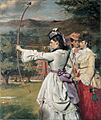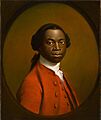Royal Albert Memorial Museum facts for kids
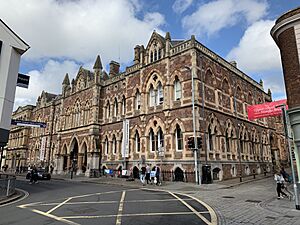
The Royal Albert Memorial Museum
|
|
| Established | 1868 |
|---|---|
| Location | Queen Street, Exeter, England |
| Visitors | 340,000 (2012) |
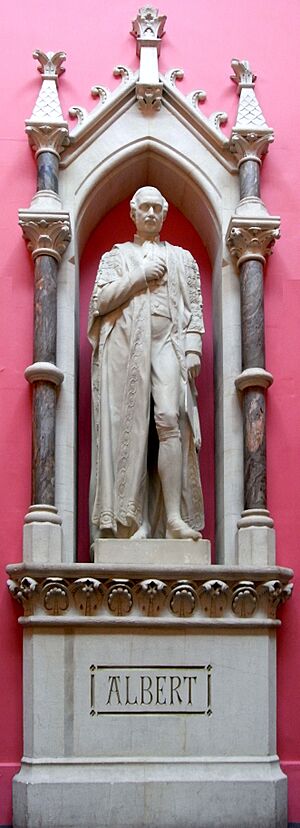
The Royal Albert Memorial Museum & Art Gallery (RAMM) is a popular museum and art gallery in Exeter, Devon, England. It is the biggest museum in the city. RAMM has amazing and varied collections. These include items about animals, people and cultures, beautiful art, and ancient objects from both local areas and around the world. It also has many geological finds.
The museum holds over one million objects in total. Only a small part of these are shown to the public at any time. RAMM gets funding from Arts Council England. This helps it to improve its services and share its collections.
RAMM first opened in 1868. It is located in a beautiful building made of local red sandstone. The building is designed in a style called Gothic Revival. It has been made bigger several times over the years. The museum recently reopened on December 15, 2011. This was after a big four-year renovation project that cost £24 million. Since then, RAMM has won many awards for its work.
Contents
Discovering RAMM's Past
How the Museum Began
The land for the museum was given by Richard Gard. He was a Member of Parliament for Exeter. A competition was held to design the building. Twenty-four architects submitted their ideas. John Hayward won with his Gothic design. His first plan included a tall central tower. However, this idea was changed to a gable and a rose window instead.
Sir Stafford Northcote first suggested the museum. He wanted it to be a useful way to remember Prince Albert. A fundraising effort started in 1861. John Gendall offered to gather the first collection of items. The first parts of the building were finished by 1868.
RAMM was very important for Exeter's cultural growth. The city's university, main library, and art college all started there. The Devon and Exeter Albert Memorial, as it was first called, offered many services. It had a museum, art gallery, free library, reading room, art school, and engineering school. This was exactly what Prince Albert had wanted.
Growing Bigger and Becoming "Royal"
The museum's collections quickly became too large for the building. This meant new parts had to be built. Extensions were added in 1894 and again in 1898. The second extension was called the York Wing. It was opened by the Duke and Duchess of York. They later became King George V and Queen Mary. At this time, the museum was given the title "Royal." From then on, it was known as the Royal Albert Memorial Museum. Over time, local people started calling it "RAMM" for short. This abbreviation is now the official name the museum uses.
For many years, the museum stayed much the same after these additions. The city library moved out of RAMM in 1930. The science school eventually grew into the University of Exeter. The art school became part of the University of Plymouth. Slowly, RAMM expanded to fill the entire building.
Modern Updates and New Discoveries
Between 2007 and 2011, RAMM had a huge renovation project. It cost £24 million. Architects Allies and Morrison designed the changes. The work included fixing the building, updating its spaces, and completely redesigning how the collections were displayed. A new entrance was also added from the historic gardens at the back. The Heritage Lottery Fund gave almost £10 million towards the cost. An off-site storage facility for collections, called the Ark, was also built.
RAMM reopened on December 15, 2011. It is free to visit from 10 am to 5 pm every day. It closes on Mondays and bank holidays. In 2024, RAMM announced a new plan. This plan makes its public collections available to everyone online. This helps more people learn about RAMM's collections and ensures they are kept safe for a long time.
Exploring RAMM's Collections
RAMM has four main types of collections. These are ancient objects, art, natural history, and world cultures. The world cultures collections are very important. The UK government recognizes them as having national and international significance.
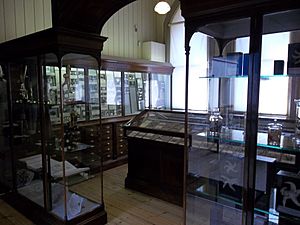
The museum's zoology collection includes many animal specimens. You can find invertebrates (animals without backbones) and mammals from all over the world. Percy Sladen's collection of echinoderms (like starfish and sea urchins) is kept here. It is considered one of the most important collections of its kind outside of national museums.
RAMM also has a very large collection of costumes and textiles. Experts say it is one of the most important collections outside of London. These items are very delicate. Because of this, they are not always on permanent display.
The art collection at RAMM has over 7,000 objects. These include paintings, drawings, prints, and sculptures. They feature important British artists. The collection also highlights artists from the South West region. Famous artists like Gainsborough, Reynolds, and Paul Nash have works here. Many generous people have helped build this collection. These include Kent Kingdon, Sir Harry Veitch, and John Lane.
Awards and Recognition
In 2012, RAMM was named the United Kingdom's museum of the year. This award was given by the Art Fund charity. They praised RAMM's "ambition and imagination."
Since its reopening, RAMM has won more than a dozen other awards. These include three regional RIBA (Royal Institute of British Architects) awards in 2013. It also won the Collections Trust award in 2013. This award recognized RAMM's excellent work in managing its collections. In 2012, it received the American Event Design Award for Best Museum Environment.
How RAMM is Funded
Exeter City Council owns and partly funds RAMM. It also receives extra money from Arts Council England. This funding comes from a program that invests in the arts. A lot of money for the museum's redevelopment came from the Heritage Lottery Fund between 2007 and 2011.
Images for kids
-
St. Sidwell’s Church, Exeter, after the Blitz by Olive Wharry
-
A Sermon in Exeter Cathedral by Thomas Rowlandson
-
Heaven by Paul Nash.












